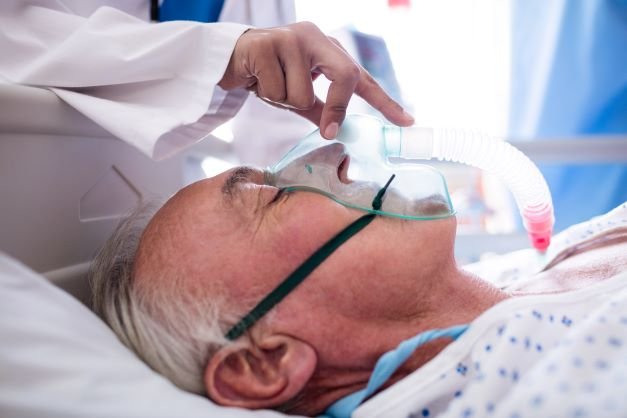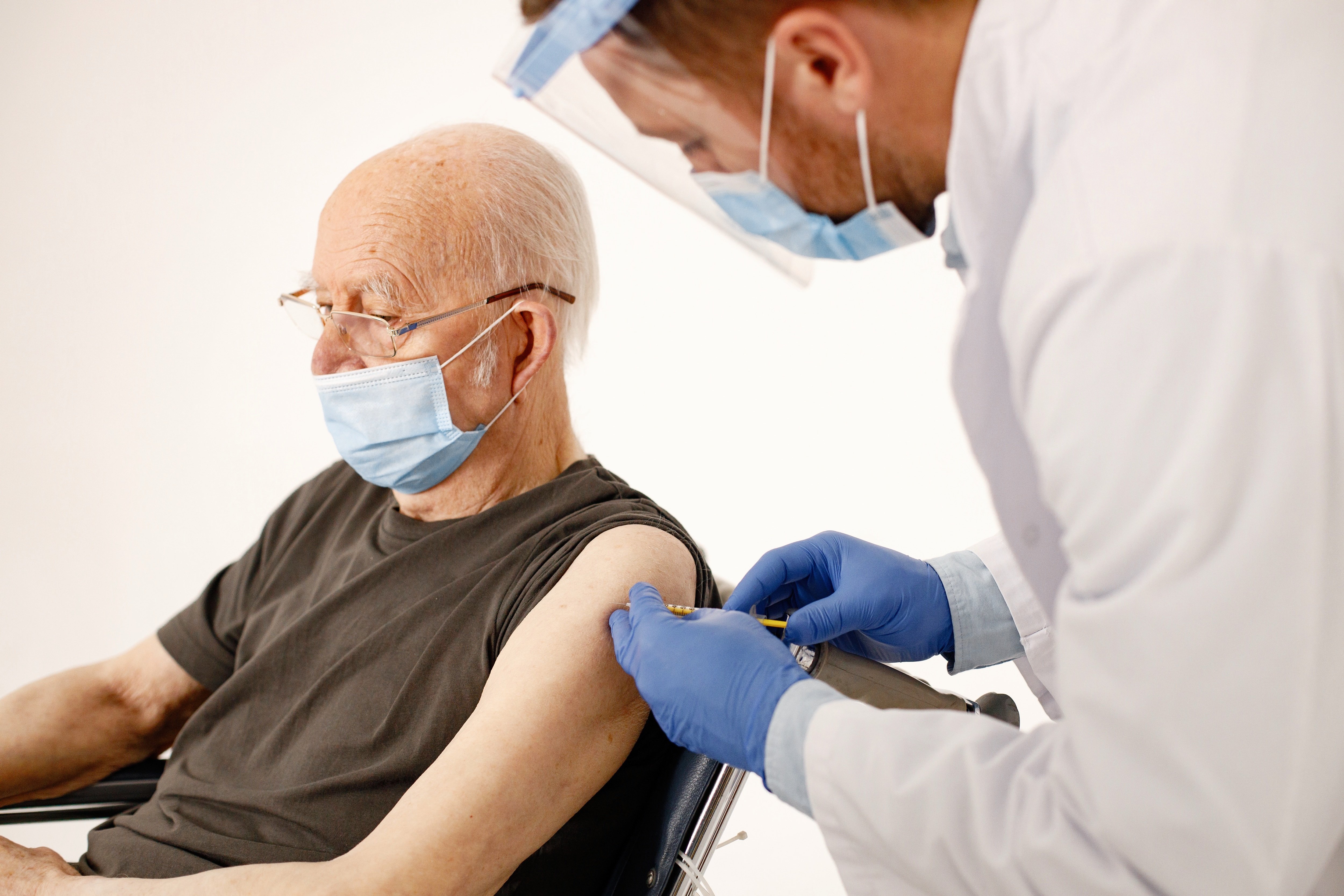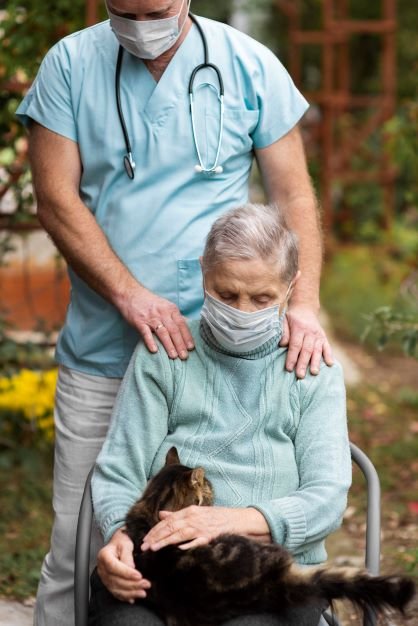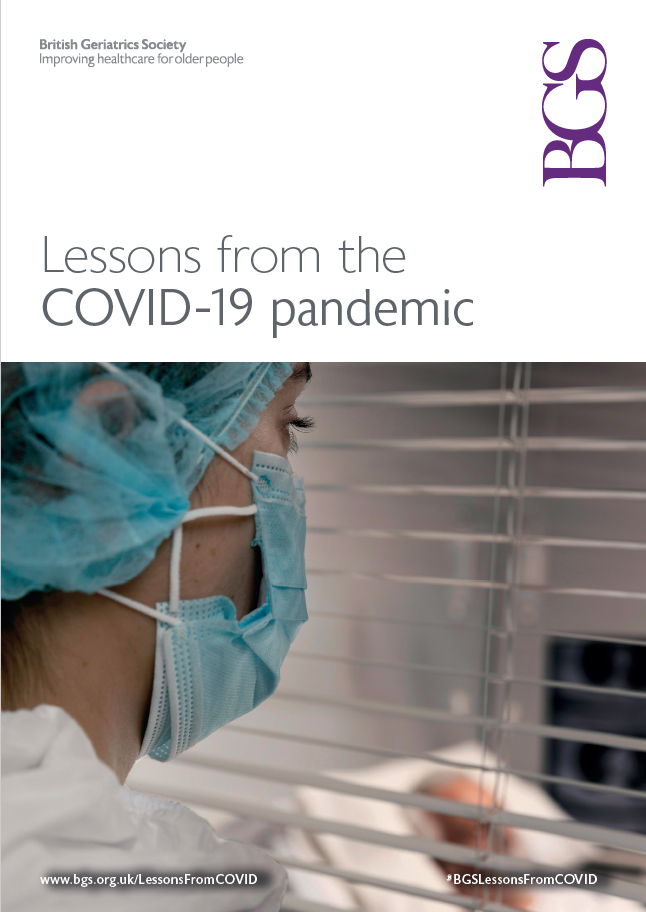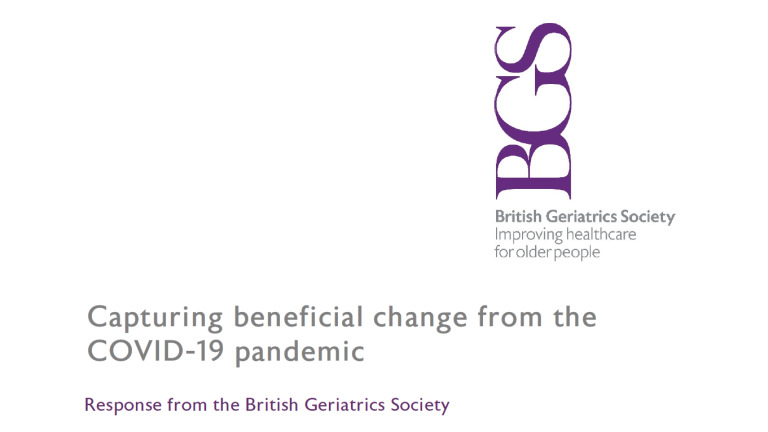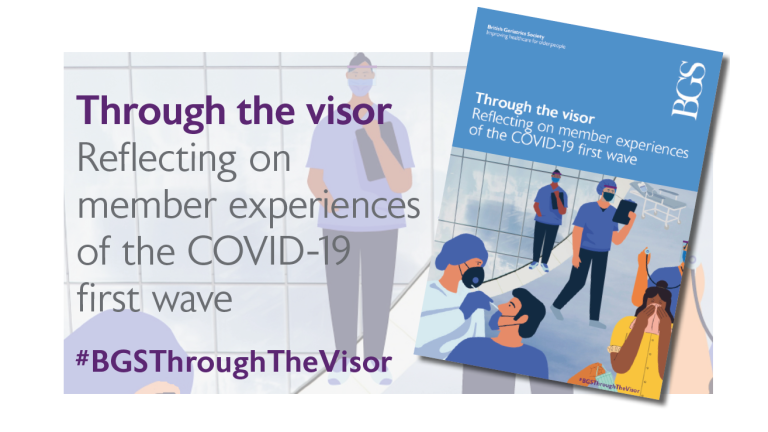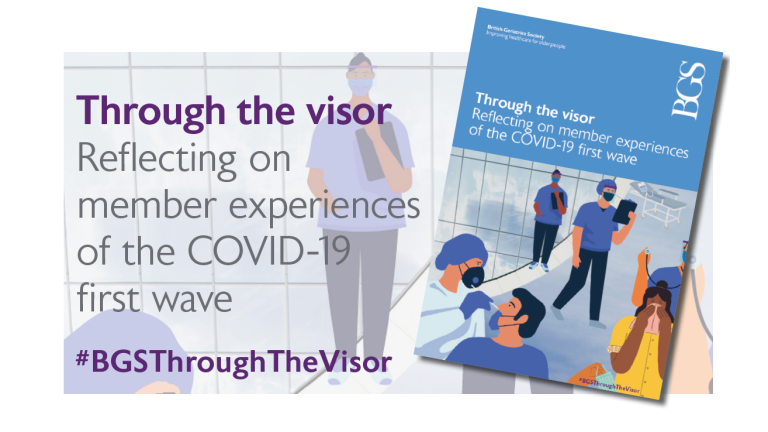Lessons from the COVID-19 pandemic
The COVID-19 pandemic had a considerable impact on BGS members, their patients, their way of working and their mental and emotional wellbeing. This report aims to capture these experiences and the learning from how the pandemic was handled. It highlights how these lessons need to be applied to healthcare for older people, in the event of another pandemic
Foreword
In 2018, I put myself forward for election as President Elect of the British Geriatrics Society, meaning I would serve as President from November 2020 to November 2022. I never could have imagined at that point that my presidency would take the shape that it has. While many of the long-lasting challenges that face the older people’s healthcare workforce have persisted over the last two years, my tenure as President has been dominated by the COVID-19 pandemic. The impact of the pandemic has been felt at every level of society and we will be dealing with the after-effects for many years to come.
Dr Jennifer Burns
BGS President
Introduction
The COVID-19 virus appeared in late 2019 and by the early months of 2020, it became clear that this virus was potentially deadly and should be taken seriously. Evidence from other countries showed that the virus spread quickly and was not easily treated, especially in the early stages. The World Health Organization (WHO) declared a public health emergency of international concern on 30 January 2020. The WHO Emergency Committee advised at that stage that it was still possible to contain the virus, if countries put into place strong measures to detect the virus early, isolate and treat cases, trace contacts and promote social distancing.1
Summary of lessons
Lesson 1Treatment decisions should always be tailored to the individual patient – blanket decisions should never be applied to an entire patient group. Lesson 2There is a need to ensure that a balance is achieved between protecting care home residents from a virus that could be fatal for them and also protecting the human rights of individuals to see their families and loved ones. Lesson 3Services should be available and adequately funded to provide patients with the most appropriate care in the best place for them. For some patients, this will be hospital. For others, it will not. Lesson 4During a pandemic, particular attention should be paid to the risk of contracting the illness in patients admitted to hospital for unrelated illnesses and measures must be taken to prevent this happening. Lesson 5Planning for the response to a pandemic should involve experts on the population most affected by the illness in question. These experts should be involved at the earliest possible stage. Lesson 6Clinical trials must include the populations most at risk and most likely to benefit from the treatments being tested. In the majority of cases, this will include older people. Lesson 7Quick development and rollout of the vaccine was essential. During a pandemic, sufficient funding should always be made available to ensure that scientists are able to collaborate and develop vaccines quickly. Lesson 8A time of great crisis can also bring great innovation. Changes made during a crisis that are beneficial to patients should be retained. Lesson 9Measures taken to curb the impact of a pandemic may have unintended but serious consequences on the health of many older people. These consequences must be identified as quickly as possible and mitigating action taken. Lesson 10NHS workforce planning must cover three crucial elements: ensuring there are enough staff, ensuring all NHS staff have the skills they need to care for the ageing population and ensuring that staff are cared for mentally and emotionally and are supported to remain working in the NHS. The impact of not doing so may be catastrophic for individuals and society. |
Rationing of healthcare
During the very early stages of the pandemic, there were concerns that the health service would not be able to cope with the number of patients, especially those who required hospitalisation or intensive care treatment. Conversations were had both privately and publicly about how to best use limited resources such as ventilators and admissions to intensive care.
| Lesson 1: Treatment decisions should always be tailored to the individual patient – blanket decisions should never be applied to an entire patient group. |
Protecting care home residents
Before the virus was widespread in the UK, news reports had emerged from other European countries, particularly Spain and Italy, showing that care home residents were at particularly high risk of contracting and dying from COVID. Statistics coming out of Europe in the early stages of the pandemic showed that there were high numbers of deaths in care homes with nearly 10% of care home residents in the province of Bergamo, Italy, dying of COVID between 7 and 27 March 2020.7 A later report from Amnesty International found that decisions made in the early stages of the pandemic resulted in a tragic loss of life in care homes across three provinces in Northern Italy.8
Despite these early warnings, early guidance from the Government in the UK did not acknowledge the increased risk posed to care home residents and staff. The shortage of testing resource contributed to delayed recognition of outbreaks. An Amnesty International report specifically looking at the situation in the UK found a raft of failings in the management of the virus in care homes. This included discharges of COVID-positive patients from hospitals into care homes, advice that personal protective equipment (PPE) was not necessary if residents and staff were not symptomatic, a failure to provide PPE, a failure to help care homes isolate infected residents and a failure to ensure regular testing of residents and staff.9 Members of the BGS recognised a lack of guidance from the Government regarding the management of the virus in a care home environment and sought to fill this gap with guidance to support healthcare professionals providing care for COVID patients in care homes.10 This guidance was welcomed by many and remains the most downloaded resource ever from the BGS website.
The UK Government claimed to have tried to protect care homes from the COVID-19 pandemic:
Right from the start, it’s been clear that this horrible virus affects older people the most. So right from the start we’ve tried to throw a protective ring around our care homes."
– The Rt Hon Matt Hancock MP, then Secretary of State for Health and Social Care, (Downing Street briefing, May 2020)11
The independent COVID inquiry is ongoing and will presumably draw its own conclusions about this. However, the High Court in England has ruled that policies from the Department of Health and Social Care in the early stages of the pandemic failed to take account of the risks posed to older and vulnerable residents from patients being discharged from hospitals to care homes without COVID testing or appropriate isolation.12
Once the risk of infection to care home residents was acknowledged, infection control policies and procedures then limited residents’ access to family support for many months and in some cases, residents were isolated in their rooms for weeks on end. Rules on visiting in care homes changed regularly with many families and care home operators struggling to keep up with what was allowed and what was not. Many of the restrictions in care homes remained in place long after restrictions were lifted in the rest of society and many family members became frustrated at not being allowed to visit their loved ones face-to-face, even once both the visitor and the resident were vaccinated. Giebel et al. have made five recommendations for Governments planning for future pandemics including the acknowledgment of family visits as a human right for care home residents and the need for better guidance for care home staff as well as improved communication with family members.13
| Lesson 2: There is a need to ensure that a balance is achieved between protecting care home residents from a virus that could be fatal for them and also protecting the human rights of individuals to see their families. |
Alternatives to hospital
For many older people, hospital is not a safe place for them to be, given the increased risk of deconditioning, delirium and nosocomial infection. During the pandemic, there were significant steps taken to establish services to provide hospital-level care at home and to expand those services that already existed. COVID virtual wards were established to allow hospitalised COVID patients whose condition was improving to be discharged while still receiving support and monitoring from the hospital team.14
While Hospital At Home and similar services have been in existence for many years, the COVID-19 pandemic has resulted in health systems around the country exploring community alternatives to acute care and in the expansion of services providing hospital care at home. In England, specific funding has been made available for virtual wards focusing on people with frailty or acute respiratory infection. Additional funding has also been made available in Scotland for Hospital at Home services. In Northern Ireland there is Government support for initiatives bringing hospital care closer to home while in Wales, the Royal College of Physicians have called for expansion of such services.15
While the evidence base for virtual wards is not yet well developed, evidence shows that Hospital at Home services are likely to be as clinically effective as inpatient services in terms of health outcomes and reducing admissions to care homes. Patient satisfaction is generally high when patients are able to be treated at home although more consideration needs to be given to the increased stress for carers. Evidence on whether these services are more cost-effective than inpatient services is not yet clear.16
The pandemic provided an opportunity to expand these services for the benefit of many patients. Sustained investment is now needed to ensure that these developments are able to continue and can be integrated with other community-based health and care services.
| Lesson 3: Services should be available and adequately funded to provide patients with the most appropriate care in the best place for them. For some patients, this will be hospital. For others, it will not. |
Hospital-acquired COVID
As the pandemic progressed, BGS members working in hospitals were increasingly caring for people who acquired COVID while in hospital (nosocomial infection). A retrospective observational study of patients with COVID-19 across 18 hospitals in Wales between March and July 2020 estimated 16.4% of cases were probably hospital-acquired with an inpatient mortality for nosocomial infection ranging from 38-42%, a level of mortality higher than in those with community-acquired infection. Those with hospital-acquired infection were older and more frail.17
The COVID in Older People (COPE) study of patients with COVID-19 in hospital, which included patients across 10 hospital sites in the UK and one in Italy, estimated 12.5% of COVID-19 infections in hospital were hospital-acquired, with an overall mortality of 27% in patients with nosocomial COVID. Increased mortality was associated with older age, increased frailty, renal failure and increased C-Reactive Protein (CRP).18
It is widely acknowledged that for many older people with frailty, hospital brings potential harms alongside the benefits of treatment. In addition to the risks of deconditioning and delirium, older people are more susceptible to acquiring infections while in hospital and COVID has proved to be no exception to this. BGS sought to provide guidance to support BGS members trying to prevent nosocomial COVID. This included ensuring staff and patients were vaccinated (once the vaccine became available), ensuring PPE was used and infection control procedures were adhered to, limiting the movement of patients between wards and sites and ensuring that hospital rooms were well-ventilated.19
Commentary during the pandemic suggested that some hospitals did better than others regarding nosocomial infection and that other countries and health systems adopted infection control methods that were more successful at preventing nosocomial infection.20
| Lesson 4: During a pandemic, particular attention should be paid to the risk of contracting the illness in patients admitted to hospital for unrelated illnesses and measures must be taken to prevent this happening. |
Expert advice
During the pandemic, the general public became much more familiar with the experts advising government than they otherwise would be. People like Professor Sir Chris Whitty, Professor Sir Patrick Vallance, Professor Sir Jonathan Van-Tam, Professor Dame Jenny Harries and Professor Sir Gregor Smith† became household names due to their roles in the daily briefings with the Prime Minister and other members of the UK and devolved Governments. The Scientific Advisory Group for Emergencies (SAGE) also became more well-known than it might otherwise have been, with many finding reassurance in knowing that the Government was being advised by so many experts.
There was therefore some dismay within BGS when it emerged that there were no geriatricians represented on SAGE or on the care homes sub-group of SAGE. This seemed a particular failing for a pandemic that affected older people more than any other population group. BGS sought to nominate experts to be involved in relevant SAGE workstreams and the Society’s President Elect was invited to join the care homes sub-group. However, unfortunately, by this stage, COVID-19 was already rampant in care homes and other settings, and our expert advice was heard too late to contribute significantly to mitigating the devastation experienced by older people across the country.
|
Lesson 5: Planning for the response to a pandemic should involve experts on the population most affected by the illness in question. These experts should be involved at the earliest possible stage. |
Research into treatments
The COVID-19 virus was new to everyone and therefore knowledge about potential treatments was limited. Research into how to treat the novel virus began quickly and the Recovery Trial21 in particular focused on people with COVID who had been hospitalised. Evidence from this trial showed the benefits of steroid use for treating COVID. Because this trial involved hospitalised patients and there was no upper age limit on participant recruitment, older people who were admitted to hospital were included in the trial. This provided vital evidence regarding the effectiveness of COVID treatments in older people and helped to inform treatment decisions later in the pandemic.
Unfortunately, trials on targeting antivirals in the community were not so inclusive and while many did not exclude older people, older people were not recognised as a specific population group that should be actively recruited to trials. BGS published a statement about the importance of involving older people in research22 and promoted trials that we were aware of with the aim of encouraging more of our members to consider participating and enrolling their patients in trials.23
Older people were the population group most affected by COVID and to exclude them or not actively include them in trials looking at treatments for the virus was a misstep and exposes a failing in research design more generally. Older people are often excluded from research, either because of their age or because they are more likely to trigger exclusion criteria regarding pre-existing conditions and concurrent medications. Despite this, most medications, once approved, will be prescribed across the board, despite a lack of evidence in those who were excluded from the trials, and in older people in particular.
It cannot be assumed that trial results for the general adult population will apply to older people. It is essential that older people are included in trials for treatments for all conditions to ensure that older people are prescribed treatments that are likely to be beneficial for them and are not exposed to those which are unlikely to be beneficial. BGS has emphasised the importance of involving older people in research and provided support to members who are involved in research to help them to recruit more of their patients to trials.24,25
Although there was investment in care home research to understand the risk factors for COVID-19 outbreaks and some work around diagnostics in the sector, funding for trials of drugs to treat and prevent COVID-19 in care home residents arrived too late. In addition, the lack of pre-existing care home trial infrastructure made this work extremely difficult. The National Institute of Health Research (NIHR) has acknowledged these concerns and work must be done now to ensure that care home research infrastructure is put on a more robust footing ahead of future healthcare crises.26
|
Lesson 6: Clinical trials must include the populations most at risk and most likely to benefit from the treatments being tested. In the majority of cases, this will include older people. |
Vaccine development and rollout
It was apparent relatively early in the pandemic that the only way society could move forward from COVID-19, or to live with the virus, would be through vaccination. This initially seemed like a long-term ambition. Anyone with any experience in the development or approval of medicines and vaccines will know that the process from bench to bedside usually takes many years. To be administering the first COVID-19 vaccine in the world in December 2020, only a year after the virus was first detected, seemed nothing short of a miracle.
The development of the vaccine in record time showed what can be achieved when scientists and pharmaceutical companies across the world work in collaboration rather than competition and when science is properly funded by governments and other funders. It is important to note that corners were not cut in the development and approval of the COVID vaccines. Rather, scientists did not have to spend precious time applying for grants and funding and instead were free to proceed with the job at hand.
The development of the vaccine is only one part of the story however. While much was made in the press about the UK being the first country to approve the vaccine for use, an arguably bigger success story was the quick rollout of the vaccine on the basis of need. The vaccine was of course made available to the entire population in due course. However, those deemed at the greatest risk from the virus (including older people, care home residents, other clinically vulnerable groups and health and social care professionals) were prioritised to receive the vaccine before other groups. This was particularly significant for care home residents who had been so neglected at earlier stages of the pandemic. Health and social care professionals had also put themselves at risk throughout the pandemic and welcomed early access to the vaccine to protect them. It was not possible to ‘jump the queue’ by paying privately to receive the vaccine. This showed the NHS at its very best, allocating resources to those who needed them most, regardless of ability to pay.
Analysis from the National Audit Office (NAO) found that the COVID-19 vaccine programme in England met targets to offer two doses of the vaccine to most adults in a short space of time and that uptake exceeded expectations and was higher than uptake of the flu vaccination in previous years. The NAO also found that considerable effort was put into making the vaccine more convenient for people to access.27
|
Lesson 7: Quick development and rollout of the vaccine was essential. During a pandemic, sufficient funding should always be made available to ensure that scientists are able to collaborate and develop vaccines quickly. |
Beneficial innovations
While bringing devastation to many, the pandemic also meant rapid changes to the way services were designed and delivered. BGS members reported the pandemic prompted removal of barriers and red tape and the ability to do things differently, more quickly and for greater patient benefit. Particular examples of this included increased use of remote meeting platforms such as Microsoft Teams both for staff meetings and patient consultations and the ability to easily share information between different providers, particularly relating to patient discharge.28
Relatively early in the pandemic, BGS sought to capture some of the changes that members had implemented in their services that had beneficial impacts for patients and published two reports about changes implemented in England and Northern Ireland. Changes documented included proactive anticipatory care for older people, introduction of hospital-level services at home, increased advance care planning, coordinated multi-agency support for care homes and increased use of digital technology in care provision.29,30
There is however concern about the longevity of such innovations, with members telling BGS that positive changes were not necessarily retained once the initial crisis had passed:
Annoyingly after the waves, things went back to how they had been: ‘this is how we always do it’.
– Consultant Geriatrician, England.28
| Lesson 8: A time of great crisis can also bring great innovation. Changes made during a crisis that are beneficial to patients should be retained. |
Impact of lockdown
These pronouncements from across the UK in March 2020 represented huge changes to the way most people lived their lives. At this stage, it was impossible to know how long this situation would last with many saying it would be a matter of weeks or up to a few months until lockdown was lifted. As it turns out, while this initial lockdown was lifted in June 2020 in England, further lockdowns were to follow with a second national lockdown introduced from November and a third introduced from January 2021.35 The final COVID-19 restrictions were not lifted until February 2022, nearly two years after the first lockdown was announced.36
The extended lockdown has had a detrimental impact on the lives of many older people with levels of physical activity and social interaction decreasing significantly. This caused an increase in the number of older people experiencing loneliness and many also physically deconditioned during lockdown. Many older people who presented to health services after lockdown had advanced frailty when they may have had mild or moderate frailty previously. Many also presented with illnesses at more advanced stages than would otherwise be expected, having delayed seeking medical treatment during the height of the pandemic. Research conducted by the charity Age UK found some concerning figures around the impact of lockdown on older people:37
- 27% of older people couldn’t walk as far as they could before the pandemic
- 17% said they are less steady on their feet than they were before the start of the pandemic
- 42% of older people who already struggled to get up and down stairs said this is harder since the pandemic
- 25% of all older people said they are living with more physical pain than they did before the pandemic
- 36% of older people said they feel more anxious since the start of the pandemic
- 43% of older people said they feel less motivated to do the things they enjoy since the pandemic
- 54% said they are less confident attending hospital appointments since the start of the pandemic.
The announcement of the lockdown at short notice gave people little time to prepare and had a considerable impact on the physical and mental health of older people. Services such as day centres and community activities such as arts or singing groups were stopped during lockdown and were often slow to restart, negatively impacting the older people who relied on them.38 The impact of the pandemic on older people was not limited to the risk contracting the virus posed to their health and lives. The effects of the lockdown are arguably greater and longer-lasting for many older people and must be considered in health service planning for the foreseeable future.
| Lesson 9: Measures taken to curb the impact of a pandemic may have unintended but serious consequences on the health of many older people. These consequences must be identified as quickly as possible and mitigating action taken. |
Workforce capacity and wellbeing
The NHS workforce has been under pressure for many years and it has been clear for a long time that there are not enough healthcare professionals to provide the level of care that the NHS promises to deliver. The pandemic placed the workforce under even more extreme pressure. NHS and social care staff were at increased risk of contracting the virus and were more likely to need to take time off and isolate, leaving services even more short-staffed. When BGS conducted a survey of its members about their experiences during the first wave of the pandemic, 40% of respondents said they took time off work during the pandemic with 71% of those saying that they had tested positive for COVID.39
To help to respond to the pandemic, many healthcare professionals were redeployed away from their normal jobs, including working on COVID wards and non-clinical staff returning to clinical duties. Three quarters of respondents to our second survey during the pandemic worked differently during the pandemic and 85% said that the intensity of their work increased.28 Many BGS members also reflected on the strength of the teamwork during the pandemic and said that they felt their teams were closer now.28
In addition to affecting the workload of health and social care professionals, the pandemic has had a significant and ongoing impact on the mental and emotional wellbeing of many health and social care professionals. Many have seen more death in a relatively short period of time among both patients and colleagues than they ever imagined they would and many have struggled to cope with this. Many BGS members have also said that the pandemic has also had an impact on the mental and emotional health of their families.
Usually a resilient person but I struggled this wave (3rd for our part of Scotland). Adrenaline kicked in in January but by February I was exhausted, crying all the time and just “done”. One of the bits I found most difficult is as a health care worker you are constantly absorbing other people’s grief - patients and relatives all telling you their stories, (we had very sad situations and high death rates in the ward), trying to support nursing colleagues and trainees as well as peers. In combination with looking after my own family who, though luckier than most, were also struggling. It was incredibly depleting."
– Consultant Geriatrician, Scotland28
Comments from BGS members in our COVID workforce survey suggest that a significant proportion of the older people’s healthcare workforce are considering ways of reducing their clinical work as a direct result of the pandemic. Some are considering early retirement while others are considering moving to less than full time hours or moving into research and other non-clinical roles. Evidence from the Royal College of Physicians London in their census of consultant physicians40 shows that there are not enough consultant geriatricians to care for the ageing population and that a worrying number of those currently working are approaching retirement. It is essential that the older people’s healthcare workforce is considered a key part of the NHS’s recovery from the pandemic and of the Government in England’s forthcoming NHS workforce plan.
While the risk of people choosing to leave the workforce because they are struggling with their mental health is significant and a cause for concern, there is also a risk of a much more tragic course of action. Statistics show that doctors are two to five times more likely to take their own life than the general population and female doctors are two and a half to four times more likely to die by suicide than male doctors. One doctor takes their own life every two to three weeks in the UK.41 Similar statistics exist for other healthcare professionals with nurses four times as likely to die by suicide than other professions and female nurses 23% more like to take their own life than the rest of the female population.42 It is important to note that these statistics are from before the pandemic – we do not currently have statistics on suicide rates among healthcare professionals since the pandemic.
|
Lesson 10: NHS workforce planning must cover three crucial elements: ensuring there are enough staff, ensuring all NHS staff have the skills they need to care for the ageing population and ensuring that staff are cared for mentally and emotionally and are supported to remain working in the NHS. The impact of not doing so may be catastrophic for individuals and society. |
Conclusions
The COVID-19 pandemic has been the biggest challenge ever to face health and social care services and the healthcare professionals who make up the membership of the BGS have been at the forefront of the clinical response to the pandemic.
The effect of the pandemic on older people has been more significant than for any other population group and the legacy of the pandemic will remain with many families for years to come, whether through grief for those who died or caring for family members who are suffering the long-term impact of the virus or the subsequent lockdown.
At the time of writing, the public inquiry into the COVID-19 pandemic is just getting under way. Over the coming months, every detail of the pandemic will be scrutinised with families and organisations most affected given the opportunity to have their say about the impact of the pandemic on them. The inquiry will analyse how prepared the Government and the health and social care systems were to cope with a pandemic of this nature and will learn lessons from the experiences of the last two and a half years.
It is unfortunately unlikely that this will be the last pandemic to affect older people more than any other group. Sadly, the pandemic exposed our society as being ageist. We were too slow to protect older people from a virus that would prove to be fatal for far too many of our older citizens. However, while many memories of the pandemic will be negative, it is important to remember the positive experiences such as the efficient development and rollout of the COVID-19 vaccination, rapid mobilisation of community and voluntary support in many areas of the country, and beneficial changes to the way NHS and social care services work and collaborate.
It is essential that everything that we have learned over the last two and a half years is retained and woven through our plans for recovery and for integration of health and social care. Most of all, we must ensure that the mistakes that were made are not repeated in future pandemics.
References
References
Click to expand
- World Health Organization, 2020. Novel Coronavirus (2019-nCoV) Situation Report – 11. Available at: www.who.int/docs/default-source/coronaviruse/situation-reports/20200131… (accessed 1 November 2022)
- Archard A and Caplan A. ‘Is it wrong to prioritise younger patients with covid-19?’ BMJ 2020;369:m1509
- Rockwood K, Song X, MacKnight C, Bergman H, Hogan DB, McDowell I and Mitnitski A, 2005. ‘A global clinical measure of fitness and frailty in older people.’ Canadian Medical Association Journal. 173 (5) 489-495
- Foster P, Staton B and Rovnick N, 2020. ‘NHS ‘score’ to decide which patients receive critical care’. The Financial Times 13 April 2020. Available at: www.ft.com/content/d738b2c6-000a-421b-9dbd-f85e6b333684 (accessed 26 September 2022)
- United Nations, 2021. Pandemic exposes ageism and age discrimination in society, says UN expert. Available at: www.ohchr.org/en/press-releases/2021/09/pandemic-exposes-ageism-and-age… (accessed 26 September 2022)
- British Geriatrics Society, 2020. BGS President responds to Sunday Times articles addressing older people’s healthcare during the first wave of the COVID-19 pandemic. Available at: https://www.bgs.org.uk/policy-and-media/bgs-president-responds-to-sunda… (accessed 26 September 2022)
- Trabucchi M and De Leo D. ‘Nursing homes or besieged castles: COVID-19 in Northern Italy.’ Lancet Psychiatry. 2020; 7: 387-388
- Amnesty International, 2020. Italy: Violations of the human rights of older residents of care homes during COVID-19 pandemic. Available at: https://www.amnesty.org/en/latest/news/2020/12/italyviolations-of-the-h… (accessed 15 September 2022)
- Amnesty International, 2020. As If Expendable: The UK Government’s failure to protect older people in care homes during the COVID-19 pandemic. Available at: www.amnesty.org/en/documents/EUR45/3152/2020/en/ (accessed 15 September 2022)
- British Geriatrics Society, 2020. COVID-19: Managing the COVID-19 pandemic in care homes for older people. Available at: www.bgs.org.uk/resources/covid-19-managing-the-covid-19-pandemic-in-car… (accessed 15 September 2022)
- 10 Downing Street, 2020. Coronavirus Press Conference (15 May 2020). Available at: www.youtube.com/watch?v=vM-2DsysyQI&t=343s (accessed 13 September 2022)
- British Geriatrics Society, 2022. BGS statement on care homes High Court ruling. Available at: https://www.bgs.org.uk/policy-and-media/bgs-statement-on-care-homes-hig… (accessed 16 September 2022)
- Giebel C, Hanna K, Cannon J, Marlow P, Tetlow H, Mason S, Shenton J, Rajagopal M and Gabbay M. ‘Are we allowed to visit now? Concerns and issues surrounding vaccination and infection risks in UK care homes during COVID-19.’ Age and Ageing. Volume 51, Issue 1, January 2022, afab229, https://doi.org/10.1093/ageing/afab229
- NHS England, undated. COVID virtual wards. Available at: www.england.nhs.uk/nhs-at-home/covid-virtual-wards/ (accessed 20 September 2022)
- British Geriatrics Society, 2022. Bringing hospital care home: Virtual Wards and Hospital at Home for older people. Available at: https://www.bgs.org.uk/virtualwards (accessed 23 September 2022)
- Norman G, Bennett P and Vardy, E. 2022 ‘Virtual wards: A rapid evidence synthesis and implications for the care of older people.’ (preprint) https://doi.org/10.1101/2022.06.24.22276864 (accessed 23 September 2022)
- Ponsford MJ, Jefferies R, Davies C, Farewell D, Humphreys IR, Jolles S, Fairbairn S, Lewis K, Menzies D, Benjamin A, Thaivalappil F, Williams C and Barry SM. ‘Burden of nosocomial COVID-19 in Wales: results from a multicentre retrospective observational study of 2508 hospitalised adults.’ BMJ Thorax. 2021;76:1246-1249
- Carter, B, Collins JT, Barlow-Pay F, Rickard F, Bruce E, Verduri A, Quinn TJ et al. ‘Nosocomial COVID-19 infection: examining the risk of mortality.’ The Journal of Hospital Infection. 2020 Oct;106(2):376-384
- British Geriatrics Society, 2021. COVID-19: Preventing nosocomial infection in older people. Available at: www.bgs.org.uk/nosocomial-covid (accessed 16 September 2022)
- Oliver D. ‘Deaths from hospital acquired covid are everyone’s problem’. BMJ 2021;373:n1492
- University of Oxford, 2022. Recovery: Randomised Evaluation of COVID-19 Therapy. Available at: www.recoverytrial.net/ (accessed 13 September 2022)
- British Geriatrics Society, 2020. COVID-19: BGS statement on research for older people during the COVID-19 pandemic. Available at: www.bgs.org.uk/resources/covid-19-bgs-statement-on-research-for-older-p… (accessed 13 September 2022)
- British Geriatrics Society, 2020. COVID-19: Research. Available at: www.bgs.org.uk/covid-19/covid-19-research (accessed 13 September 2022)
- British Geriatrics Society, 2018. Increasing participation of older people in research. Available at:www.bgs.org.uk/resources/increasing-participation-of-older-people-in-re… (accessed 13 September 2022)
- British Geriatrics Society, 2018. Recruitment of older people to research. Available at: https://www.bgs.org.uk/resources/recruitment-of-older-people-to-research (accessed 13 September 2022)
- Gordon A, Rick C, Juszczak E, Montgomery A, Howard R, Guthrie B, Lim W, Shenkin S, Leighton P, Bath P and The PROTECT-CH Triallists. ‘The COVID-19 pandemic has highlighted the need to invest in care home research infrastructure.’ Age and Ageing. Volume 51, Issue 3, March 2022, afac052, https://doi.org/10.1093/ageing/afac052
- National Audit Office, 2022. The rollout of the COVID-19 vaccination programme in England. Available at: www.nao.org.uk/wp-content/uploads/2022/02/The-rollout-of-the-COVID-19-v… (accessed 1 November 2022)
- British Geriatrics Society, 2021. Through the Visor 2: Further learning from member experiences during COVID-19. Available at: https://www.bgs.org.uk/throughthevisor2 (accessed 23 September 2022)
- British Geriatrics Society, 2020. Beneficial Innovations from COVID-19. Available at: https://www.bgs.org.uk/policy-and-media/beneficial-innovations-from-cov… (accessed 23 September 2022)
- British Geriatrics Society, 2020. Beneficial innovations from the COVID-19 pandemic in Northern Ireland. Available at: https://www.bgs.org.uk/resources/beneficial-innovations-from-the-covid-… (accessed 23 September 2022)
- Prime Minister’s Office, 10 Downing Street and the Rt Hon Boris Johnson MP, 2020. Prime Minister’s Statement on Coronavirus (COVID-19): 23 March 2020. Available at: https://www.gov.uk/government/speeches/pm-address-to-the-nation-on-coro… (accessed 23 September 2022)
- Scottish Government, 2020. Coronavirus (COVID-19) update: First Minister’s speech 23 March 2020. Available at: www.gov.scot/publications/first-minister-covid-19-update-1 (accessed 23 September 2022)
- Welsh Government, 2020. First Minister of Wales’ statement on new coronavirus measures. Available at: https://gov.wales/first-minister-of-wales-statement-on-new-coronavirus-… (accessed 23 September 2022)
- The Executive Office, 2020. Executive approves new powers to protect the public. Available at: www.executiveoffice-ni.gov.uk/news/executive-approves-new-powers-protec… (accessed 23 September 2022)
- Institute for Government, undated. Timelines of UK coronavirus lockdowns, March 2020 to March 2021. Available at: https://www.instituteforgovernment.org.uk/sites/default/files/timeline-… (accessed 23 September 2022)
- UK Health Security Agency, 2022. Public reminded to stay safe as COVID-19 England restrictions lifted. Available at: https://www.gov.uk/government/news/public-reminded-to-stay-safe-as-covi… (accessed 23 September 2022)
- Age UK, 2021. Impact of Covid-19 on older people’s physical and mental health: one year on. Available at: https://www.ageuk.org.uk/globalassets/age-uk/documents/reports-and-publ… (accessed 23 September 2022)
- Giebel C, Pulford D, Cooper C, Lord K, Shenton J, Cannon J, Shaw L, Tetlow H, Limbert S, Callaghan S, Whittington R, Rogers C, Komuravelli A, Rajagopal M, Eley R, Downs M, Reilly S, Ward K, Gaughan V, Butchard S, Beresford J, Watkins C, Bennett K and Gabbay M. ‘COVID-19-related social support service closures and mental well-being in older adults and those affected by dementia: a UK longitudinal survey’. BMJ Open 2021;11:e045889. doi: 10.1136/bmjopen-2020-045889
- British Geriatrics Society, 2020. Through the visor: Reflecting on members experiences of the COVID-19 first wave. Available at: www.bgs.org.uk/ThroughTheVisor (accessed 27 September 2022)
- Royal College of Physicians London, 2021. Census data toolkits. Available at: www.rcplondon.ac.uk/guidelines-policy/census-data-toolkits (accessed 27 September 2022)
- Doctors in Distress, 2021. Our Story. Available at: https://doctors-in-distress.org.uk/our-story (accessed 4 October 2022)
- Davies, N. 2020. ‘The suicide crisis in nursing’. Independent Nurse. Available at: www.independentnurse.co.uk/professional-article/the-suicide-crisis-in-n… (accessed 4 October 2022).







